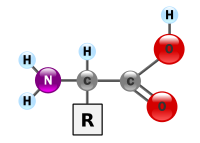
Photo from wikipedia
To determine whether children in a population with a high prevalence of kwashiorkor (HPP) have lower dietary intakes of Sulfur Amino Acids (SAAs) than children in a low-prevalence population (LPP).… Click to show full abstract
To determine whether children in a population with a high prevalence of kwashiorkor (HPP) have lower dietary intakes of Sulfur Amino Acids (SAAs) than children in a low-prevalence population (LPP). A cross-sectional census survey design of 358 children was used to compare two adjacent populations of children 36 to 59 months old in North Kivu Province of the Democratic Republic of the Congo. One population had a high prevalence of kwashiorkor (4.5%) and the other had a low prevalence (1.7%). Data collected included urinary sulfate and thiocyanate, linamarin in cassava-based food products, recent history of illness, and a 24-hour quantitative diet recall for the child. Median intake of SAAs was 32.4 mg/kg for the LPP and 29.6 mg/kg for the HPP (P < 0.05). A higher percentage of children in the HPP were at risk for inadequate intake of SAAs than in the LPP (23.2% versus 13.3%, P < 0.05). Methionine was the first limiting amino acid in both populations, with the highest risk for inadequate intake among children in the HPP (35.1% versus 23.6%, P < 0.05). Children in a population with a higher prevalence of kwashiorkor have lower dietary intake of SAAs than children in a population with a lower prevalence. Interventions to reduce incidence of kwashiorkor should consider increasing SAA intake with particular attention to methionine. Private donors, USAID/Office of Foreign Disaster Assistance through Action Against Hunger, Dignitas Foundation through the Feinstein International Center. CD was supported in part by funds from the NIH. SG was supported in part by funds from USAID.
Journal Title: Current Developments in Nutrition
Year Published: 2020
Link to full text (if available)
Share on Social Media: Sign Up to like & get
recommendations!